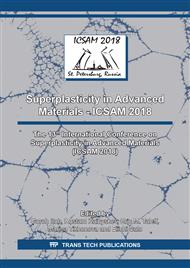[1]
Banerjee D, Gogia A K, Nandi T K, et al. A new ordered orthorhombic phase in a Ti3Al-Nb alloy. Acta Metallurgica, 1988, 36(4):871-882.
DOI: 10.1016/0001-6160(88)90141-1
Google Scholar
[2]
Boehlert C J, Miracle D B. The tensile behavior of Ti-Al-Nb O+Bcc orthorhombic alloys. Metallurgical and Materials Transactions A, 2001, 32(8):1977-(1988).
DOI: 10.1007/s11661-001-0010-4
Google Scholar
[3]
Braun R, Leyens C. Protective coatings on orthorhombic Ti2AlNb alloys. Microscopy of Oxidation. DLR, 2014:437-447.
Google Scholar
[4]
Lin P, He Z, Yuan S, et al. Tensile deformation behavior of Ti-22Al-25Nb alloy at elevated temperatures[J]. Materials Science & Engineering A, 2012, 556(11):617-624.
DOI: 10.1016/j.msea.2012.07.036
Google Scholar
[5]
Xu B, Zeng WD, He DH, Zhou YG, Liang XB, Li SQ. Study on hot deformation behavior of Ti-22Al-25Nb alloy. Hot Working Technology, 2007, 36(1): 1-4. (in Chinese).
Google Scholar
[6]
Lin P, Hao Y, Zhang B, et al. Strain rate sensitivity of Ti-22Al-25Nb (at%) alloy during high temperature deformation. Materials Science & Engineering A, 2018, 710:336-342.
DOI: 10.1016/j.msea.2017.10.112
Google Scholar
[7]
Shao B, Zong Y, Wen D, et al. Investigation of the phase transformations in Ti-22Al-25Nb alloy. Materials Characterization, 2016, 114:75-78.
DOI: 10.1016/j.matchar.2016.02.011
Google Scholar
[8]
Wang C W, Zhao T, Wang G, et al. Superplastic forming and diffusion bonding of Ti-22Al-24Nb alloy. Journal of Materials Processing Technology, 2015, 222:122-127.
DOI: 10.1016/j.jmatprotec.2015.03.005
Google Scholar
[9]
Li XF, Jiang J, Wang S, Chen J, Wang YQ. Effect of hydrogen on the microstructure and superplasticity of Ti-55 alloy. International Journal of Hydrogen Energy, 2017,42(9):6338-6349.
DOI: 10.1016/j.ijhydene.2017.01.018
Google Scholar
[10]
Li XF, Chen NN, Chen J, Mei QF, Li Wan, Jia CL, Liu H. Superplastic deformation behavior of Ti-55 alloy without and with 0.1wt%H addition. Materials Science & Engineering A, 2017, 704:386-390.
DOI: 10.1016/j.msea.2017.08.009
Google Scholar
[11]
Zhang XM, Zhao YQ, Zeng WD. Effect of hydrogen on the superplasticity of Ti600 alloy. Int J Hydrogen Energy, 2010,35(9):4354-4360.
DOI: 10.1016/j.ijhydene.2010.01.110
Google Scholar
[12]
Lu JQ, Qin JN, Lu WJ, Chen YF, Zhang ZW, Zhang D, et al. Superplastic deformation of hydrogenated Ti-6Al-4V alloys. Mat Sci Eng A 2010, 527:4875-4880.
DOI: 10.1016/j.msea.2010.04.008
Google Scholar


